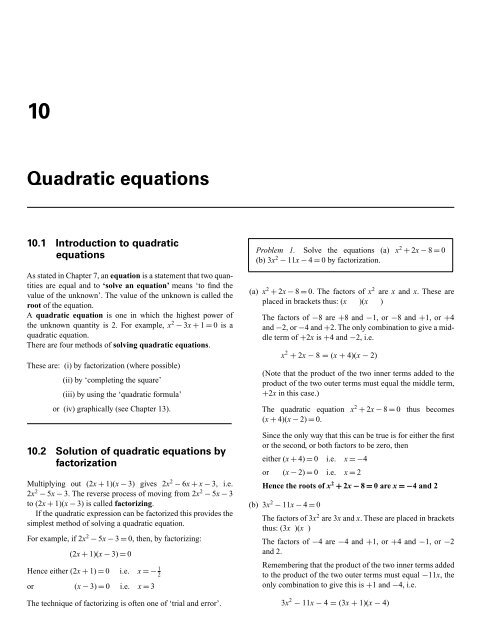basic_engineering_mathematics0
You also want an ePaper? Increase the reach of your titles
YUMPU automatically turns print PDFs into web optimized ePapers that Google loves.
10<br />
Quadratic equations<br />
10.1 Introduction to quadratic<br />
equations<br />
As stated in Chapter 7, an equation is a statement that two quantities<br />
are equal and to ‘solve an equation’ means ‘to find the<br />
value of the unknown’. The value of the unknown is called the<br />
root of the equation.<br />
A quadratic equation is one in which the highest power of<br />
the unknown quantity is 2. For example, x 2 − 3x + 1 = 0isa<br />
quadratic equation.<br />
There are four methods of solving quadratic equations.<br />
These are: (i) by factorization (where possible)<br />
(ii) by ‘completing the square’<br />
(iii) by using the ‘quadratic formula’<br />
or (iv) graphically (see Chapter 13).<br />
10.2 Solution of quadratic equations by<br />
factorization<br />
Multiplying out (2x + 1)(x − 3) gives 2x 2 − 6x + x − 3, i.e.<br />
2x 2 − 5x − 3. The reverse process of moving from 2x 2 − 5x − 3<br />
to (2x + 1)(x − 3) is called factorizing.<br />
If the quadratic expression can be factorized this provides the<br />
simplest method of solving a quadratic equation.<br />
For example, if 2x 2 − 5x − 3 = 0, then, by factorizing:<br />
(2x + 1)(x − 3) = 0<br />
Hence either (2x + 1) = 0 i.e. x =− 1 2<br />
or (x − 3) = 0 i.e. x = 3<br />
The technique of factorizing is often one of ‘trial and error’.<br />
Problem 1. Solve the equations (a) x 2 + 2x − 8 = 0<br />
(b) 3x 2 − 11x − 4 = 0 by factorization.<br />
(a) x 2 + 2x − 8 = 0. The factors of x 2 are x and x. These are<br />
placed in brackets thus: (x )(x )<br />
The factors of −8 are +8 and −1, or −8 and +1, or +4<br />
and −2, or −4 and +2. The only combination to give a middle<br />
term of +2x is +4 and −2, i.e.<br />
x 2 + 2x − 8 = (x + 4)(x − 2)<br />
(Note that the product of the two inner terms added to the<br />
product of the two outer terms must equal the middle term,<br />
+2x in this case.)<br />
The quadratic equation x 2 + 2x − 8 = 0 thus becomes<br />
(x + 4)(x − 2) = 0.<br />
Since the only way that this can be true is for either the first<br />
or the second, or both factors to be zero, then<br />
either (x + 4) = 0 i.e. x =−4<br />
or (x − 2) = 0 i.e. x = 2<br />
Hence the roots of x 2 + 2x − 8 = 0arex =−4 and 2<br />
(b) 3x 2 − 11x − 4 = 0<br />
The factors of 3x 2 are 3x and x. These are placed in brackets<br />
thus: (3x )(x )<br />
The factors of −4 are −4 and +1, or +4 and −1, or −2<br />
and 2.<br />
Remembering that the product of the two inner terms added<br />
to the product of the two outer terms must equal −11x, the<br />
only combination to give this is +1 and −4, i.e.<br />
3x 2 − 11x − 4 = (3x + 1)(x − 4)















![[Lonely Planet] Sri Lanka](https://img.yumpu.com/59845622/1/169x260/lonely-planet-sri-lanka.jpg?quality=85)

